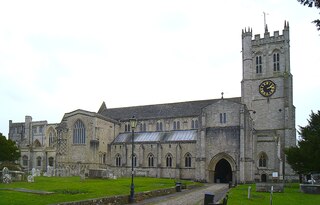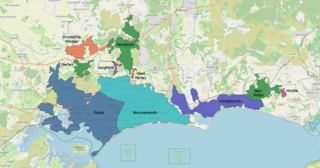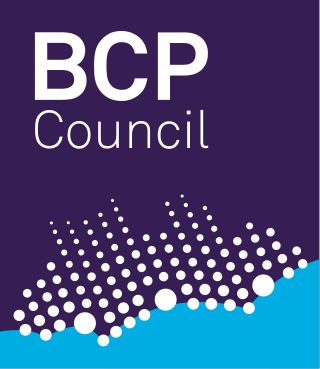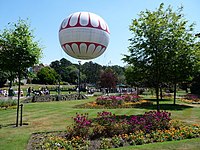
Bournemouth is a coastal resort town on the south coast in the Bournemouth, Christchurch and Poole unitary authority area in the ceremonial county of Dorset, England. The town's urban subdivision had a population of 187,503 at the 2011 census making it the largest town in the county; the town is part of the South East Dorset conurbation, which has a population of 465,000.

Christchurch is a town and civil parish on the south coast of Dorset, England. The parish had a population of 31,372 in 2021. It adjoins Bournemouth to the west, with the New Forest to the east. Part of the historic county of Hampshire, Christchurch was a borough within the administrative county of Dorset from 1974 until 2019, when it became part of the new Bournemouth, Christchurch and Poole unitary authority.

Poole is a coastal town and seaport on the south coast of England in the Bournemouth, Christchurch and Poole unitary authority area in Dorset, England. The town is 21 miles (34 km) east of Dorchester and adjoins Bournemouth to the east. Since 1 April 2019, the local authority is Bournemouth, Christchurch and Poole Council. The town had an estimated population of 151,500 making it the second-largest town in the ceremonial county of Dorset. Together with Bournemouth and Christchurch, the conurbation has a total population of nearly 400,000.

Branksome is a suburb of Poole, in the Bournemouth, Christchurch and Poole district, in the ceremonial county of Dorset, England. The area consists of residential properties and also a number of commercial and industrial areas.

The South East Dorset conurbation is a multi-centred conurbation on the south coast of Dorset in England.

Bournemouth Borough Council was the local authority of Bournemouth in Dorset, England and ceased to exist on 1 April 2019. It was a unitary authority, although between 1974 and 1997 it was an administrative district council with Dorset. Previously most of the borough was part of Hampshire.

The history of Bournemouth and human settlement in the surrounding area goes back for thousands of years. Bournemouth is a coastal town on the island of Great Britain in Dorset, England, United Kingdom.
Poole was a unitary authority in Dorset, England from 1997 to 2019. From 1974 until 1 April 1997 it was a non-metropolitan district. In 2019 it was abolished and subsumed into Bournemouth, Christchurch and Poole Council.

Bournemouth, Christchurch and Poole (BCP) is a local government district in the ceremonial county of Dorset, England. Its council is a unitary authority, being a district council which also performs the functions of a county council. The district was created on 1 April 2019 by the merger of the areas that were previously administered by the unitary authorities of Bournemouth and Poole, and the non-metropolitan district of Christchurch. The authority covers much of the area of the South Dorset conurbation.

Bournemouth, Christchurch and Poole Council, which styles itself BCP Council, is the local authority for Bournemouth, Christchurch and Poole, a local government district in the ceremonial county of Dorset, England. The council is a unitary authority, being a district council which also performs the functions of a county council. It is independent from Dorset Council, the unitary authority which administers the rest of the county.

The Party for Poole People is a movement and local political party in Poole, Dorset, England. Defining itself as neither left or right wing, the party has stood in elections for the former Poole Borough Council and the Bournemouth, Christchurch and Poole Council which replaced it. On the council it is part of the Poole Independents Group, which includes all three Poole People Councillors, one Alliance for Local Living (ALL) Councillor and one independent Councillor. It was previously part of the "Unity Alliance" administration on Bournemouth, Christchurch and Poole Council from 2019 until a vote of no confidence in 2020, after which the party has been in opposition. It was founded in 2010 by Mark Howell, and has contested three local elections, as well as the Poole constituency in the 2015 UK general election.

The 2019 Bournemouth, Christchurch and Poole Council election took place on 2 May 2019 to elect the inaugural members of Bournemouth, Christchurch and Poole Council in England, formed from the former unitary authorities of Bournemouth and Poole, and borough of Christchurch. At the same time an election for the new Christchurch Town Council was held.

The Alliance for Local Living (ALL) was a minor localist party and political group based in Dorset, with separate branches in the two authorities, ALL for Bournemouth, Christchurch and Poole and ALL for Dorset. The BCP office was based in Poole, whilst the Dorset office was based in Weymouth. The party was deregistered in November 2023, at which point it had four councillors on Dorset Council, who continued to sit together as an informal grouping. The group became Independents for Dorset in 2024.

Poole Civic Centre is an Art Deco municipal building in Poole, Dorset. Since 7 October 2019 the building has been a Grade II listed building. Also sometimes known as Poole Town Hall, the civic centre was the headquarters of Poole Borough Council until 2019.

The Town Hall, Christchurch is a municipal building in Christchurch, Dorset, England. The building, which incorporates a room known as the mayor's parlour on the first floor, and is a Grade II listed building. It is currently the base of Christchurch Town Council.

Alderney and Bourne Valley is a ward in Poole, Dorset. Since 2019, the ward has elected 3 councillors to Bournemouth, Christchurch and Poole Council.

East Cliff and Springbourne is a ward in Bournemouth, Dorset. Since 2019, the ward has elected 3 councillors to Bournemouth, Christchurch and Poole Council.



















